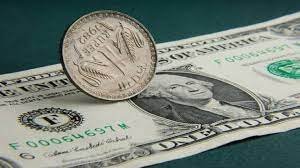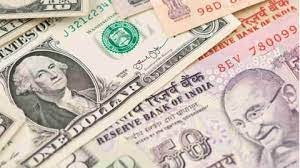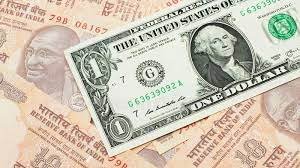
In a seismic twist, the Indian Rupee has nosedived to an unparalleled low of 83.41 against the US Dollar, jolting the financial panorama with reverberations that echo through the corridors of economic stability. This precipitous decline unfurls a tapestry of economic intricacies, with myriad factors converging to orchestrate this disconcerting spectacle in the labyrinthine realm of foreign exchange.
Decoding the Numbers
The Rupee’s descent to 83.41 marks a watershed moment in the annals of its fiscal performance. This downtrend, etched across a series of trading sessions, has prompted discerning scrutiny of the economic bedrock, provoking contemplation on the undercurrents steering this unsettling narrative.
The Dollar’s Hegemony: Power Play at the Epicenter
At the core of this financial tempest lies the resolute ascendancy of the US Dollar. Recent economic cues have precipitated an upswing in Dollar demand, casting a looming shadow over the currencies of emerging markets. The robust fortitude of the US economy and the optimistic sentiment swirling around the Dollar in the global fiscal arena have erected formidable challenges for currencies akin to the beleaguered Rupee.
Transitioning from 83.37 to 83.41 may ostensibly appear as a marginal shift, yet in the intricate choreography of foreign exchange dynamics, every decimal increment assumes weighty significance. This downward tick serves as an intensified skirmish for the Rupee, wrestling against the Dollar’s dominance on the international monetary stage.
A Global Melange: Placing the Rupee’s Struggle in a Broader Context

To unravel the conundrum of the Rupee, it is imperative to embed it within the broader matrix of global economic dynamics. The Dollar’s supremacy is not an isolated phenomenon but intricately woven into a tapestry of multifaceted elements, including the policies of the Federal Reserve, international trade tensions, and geopolitical uncertainties.
In the interlaced ballet of global finances, the Rupee’s depreciation serves as a metronome, measuring the intricate dance between economies worldwide. Analysts posit that decoding these global nuances is pivotal to unraveling the trajectory of the Rupee and crafting effective economic strategies.
Catalysts of the Decline: A Tangle of Interconnected Forces
Several intertwined factors have coalesced to steer the Rupee toward this unprecedented low. Foremost among these is the robust performance of the US economy, creating a gravitational pull that attracts capital and escalates the demand for the Dollar. The resultant appreciation of the Dollar exerts immense pressure on other currencies, with the Rupee bearing the brunt of this financial force.
Simultaneously, the descent in crude oil prices, conventionally a boon for a net oil-importing nation like India, sparks contemplation against the broader economic canvas. While a dip in oil prices traditionally eases the import bill, the recent decline raises questions. Could this be indicative of a broader global economic slowdown, triggering a flight to safety and, subsequently, an increased demand for the US Dollar?
Economic Repercussions: The Ripple Effect on India
The depreciation of the Rupee against the US Dollar unfurls a cascade of economic implications for India. One immediate consequence is the reverberation on import costs. With a weakened Rupee, the expense of importing goods and services, especially those denominated in foreign currencies, is poised to surge. This surge could contribute to inflationary pressures, impacting consumers and businesses alike.
Additionally, the nation’s trade equilibrium may sway as the cost of imports elevates relative to exports. While export-oriented industries could stand to gain from a feeble Rupee, potentially amplifying the competitiveness of Indian products globally, this advantage must be carefully weighed against the augmented costs of imported raw materials.
Furthermore, the Rupee’s depreciation could impel the Reserve Bank of India (RBI) to recalibrate its monetary policy. The RBI may need to contemplate measures to stabilize the currency and manage inflation, potentially adjusting interest rates and liquidity conditions to address these challenges and uphold overall economic equilibrium.
Insights from Maestros: Echoes in the Halls of Economic Wisdom
Economists and financial sages have swiftly proffered their insights into this economic labyrinth. Seasoned economists opine that “The Rupee’s depreciation encapsulates the intricate challenges posed by the current global economic climate. India must embrace a nuanced approach, factoring in both domestic and international variables to navigate these turbulent waters.” They further suggest that “A diverse reserve basket acts as a shield against external shocks, providing stability to the Rupee during tumultuous times.”
Governmental Vigilance: Navigating Uncharted Territories
As the Rupee grapples with this unprecedented nadir, the government’s response emerges as the focal point of discourse. Finance Minister [Name] has assuaged the public, asserting that the government vigilantly monitors the situation. The pledge of requisite measures, be they policy adjustments, market interventions, or initiatives to allure foreign investments, resonates through the corridors of economic policy formulation.
Market Oscillations: A Symphony of Financial Flux
The financial markets have swiftly responded to the Rupee’s descent. Stock prices, bond yields, and commodity markets are undergoing tangible undulations as investors recalibrate their portfolios in response to this currency upheaval. Businesses find themselves at a crossroads, reevaluating strategies in the face of evolving economic conditions.
The Rupee’s Odyssey: a Global Economic Overture

The Rupee’s unprecedented plunge to 83.41 against the US Dollar is not merely a numerical anomaly; it is a symphony of economic intricacies, resonating on the global stage. As India grapples with the economic ramifications of this downturn, strategic measures and a comprehensive approach become paramount. The journey from 83.37 to 83.41 may appear incremental, yet the impact on India’s economic trajectory is nothing short of monumental.
Amidst this economic maelstrom, the true litmus test lies in navigating the turbulence, implementing sagacious policies, and cultivating an environment conducive to sustained growth. The Rupee’s journey mirrors the broader economic narrative, and deciphering its nuances is imperative for charting a course towards stability and prosperity.










